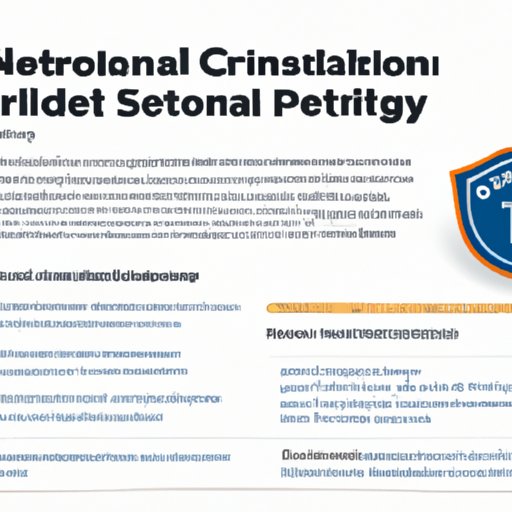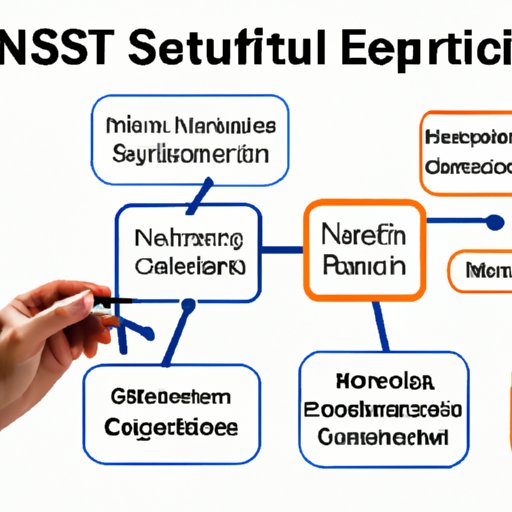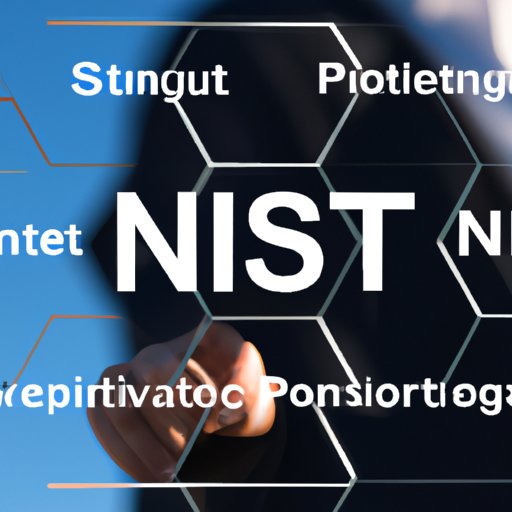Introduction
The National Institute of Standards and Technology (NIST) Cybersecurity Framework is a set of industry-wide standards and best practices that organizations can use to protect their networks and systems from cyber threats. The Framework was developed by the U.S. Department of Commerce to provide a comprehensive approach to cybersecurity that is tailored to the needs of any organization. In this article, we explore the benefits of NIST Cybersecurity Framework for businesses and discuss the different components of the Framework.

Examining the Benefits of NIST Cybersecurity Framework for Businesses
The NIST Cybersecurity Framework provides numerous benefits to businesses, such as enhancing their security posture, improving data protection, strengthening incident response, and even saving money. Let’s take a closer look at each of these benefits:
Enhancing Security Posture
Organizations that adopt the NIST Cybersecurity Framework are better equipped to identify, assess, and manage risks associated with cyber threats. According to a 2017 study by IBM Security, “By leveraging the NIST Cybersecurity Framework, organizations can improve their security posture and gain a better understanding of how to effectively protect their critical assets.” This helps organizations to be better prepared for potential cyberattacks and reduce the likelihood of a successful attack.
Improving Data Protection
The NIST Cybersecurity Framework provides organizations with guidance on how to properly protect sensitive data. This includes implementing secure authentication protocols, encrypting data at rest and in transit, and regularly monitoring access to sensitive systems. These measures help organizations to ensure that their data is protected from unauthorized access and ensure compliance with relevant regulations.
Strengthening Incident Response
In the event of a cyberattack, the NIST Cybersecurity Framework helps organizations to respond quickly and effectively. The Framework outlines processes for identifying, responding to, and recovering from incidents, which helps organizations to minimize the impact of an attack and return to normal operations as soon as possible.
Cost Savings
Adopting the NIST Cybersecurity Framework can also help organizations to save money by reducing the costs associated with cybersecurity. For example, organizations can reduce the costs of implementing and maintaining security solutions, as well as the costs associated with responding to and recovering from cyber incidents.

NIST Cybersecurity Framework: A Comprehensive Guide to Security Solutions
The NIST Cybersecurity Framework provides organizations with a comprehensive guide to security solutions. It outlines five core functions that organizations should focus on when developing their security program: Identify, Protect, Detect, Respond, and Recover.
Overview of the Framework
The NIST Cybersecurity Framework consists of three components: Core, Profiles, and Implementation Tiers. The Core component outlines the five core functions of the Framework, while the Profiles component allows organizations to customize their security programs based on their specific needs. Finally, the Implementation Tiers component provides guidance on how organizations can implement the Framework according to their risk management objectives.
Identifying Risk Areas
In order to effectively protect their networks and systems, organizations need to first identify their risk areas. The NIST Cybersecurity Framework provides guidance on how to identify potential threats and vulnerabilities, which helps organizations to prioritize their security efforts and allocate resources accordingly.
Establishing an Effective Cybersecurity Program
Once organizations have identified their risk areas, they can use the NIST Cybersecurity Framework to develop an effective security program. This includes implementing appropriate controls, establishing policies and procedures, and regularly monitoring access to sensitive systems. All of these measures help organizations to protect their networks and systems from cyber threats.
Understanding the Necessity of NIST Cybersecurity Framework in the Digital Age
In today’s digital world, it is essential for organizations to have a robust security program in place. The NIST Cybersecurity Framework provides organizations with the necessary guidance to ensure they are adequately protected from cyber threats. Here are some of the reasons why organizations should adopt the Framework:
The Need for Better Security Measures
As cyber threats continue to evolve, organizations need to stay ahead of the curve by implementing the latest security measures. The NIST Cybersecurity Framework provides organizations with the tools they need to protect their networks and systems from the latest threats.
Keeping Up with Changing Technology
Technology is constantly changing, and organizations need to keep up with these changes in order to remain secure. The NIST Cybersecurity Framework helps organizations to identify and address potential security gaps caused by new technology.
Meeting Compliance and Regulatory Requirements
Organizations must adhere to applicable laws and regulations when it comes to protecting sensitive data. The NIST Cybersecurity Framework helps organizations to meet these requirements by providing comprehensive guidance on how to properly secure their systems.
How NIST Cybersecurity Framework Can Help Organizations Improve Their Security Posture
Organizations can use the NIST Cybersecurity Framework to enhance their security posture and protect their networks and systems from cyber threats. Here are some of the ways in which the Framework can help organizations to improve their security posture:
Implementing Best Practices
The NIST Cybersecurity Framework provides organizations with best practices for implementing security controls and monitoring access to sensitive systems. This helps organizations to ensure their security measures are up to date and effective.
Establishing a Culture of Security
The Framework also outlines processes for creating a culture of security within an organization. This includes educating employees on the importance of security, establishing clear policies and procedures, and holding regular security reviews. All of these measures help organizations to create an environment where security is taken seriously.
Creating an Adaptive Security Environment
Finally, the NIST Cybersecurity Framework helps organizations to create an adaptive security environment. This includes regularly assessing security risks, implementing appropriate controls, and keeping up with changing technology. By taking a proactive approach to security, organizations can ensure their networks and systems are adequately protected.
The Pros and Cons of Adopting NIST Cybersecurity Framework
While the NIST Cybersecurity Framework provides numerous benefits for businesses, there are also some challenges that organizations should consider before adopting the Framework. Let’s take a look at the pros and cons of adopting the Framework:
Advantages
- Provides comprehensive guidance on security solutions
- Helps organizations to identify and address potential threats and vulnerabilities
- Enables organizations to meet compliance and regulatory requirements
- Can help organizations to save money by reducing the costs associated with cybersecurity
Challenges
- Implementing the Framework can be time consuming and costly
- Requires organizations to regularly update their security measures
- Organizations must dedicate resources to monitoring access to sensitive systems

Exploring the Different Components of NIST Cybersecurity Framework
The NIST Cybersecurity Framework consists of five core functions: Identify, Protect, Detect, Respond, and Recover. Let’s take a closer look at each of these components:
Identify
The Identify component of the Framework focuses on identifying potential threats and vulnerabilities, as well as the assets that need to be protected. Organizations should use this component to assess their risk areas and prioritize their security efforts.
Protect
The Protect component of the Framework outlines measures for protecting assets from potential threats. This includes implementing secure authentication protocols, encrypting data at rest and in transit, and regularly monitoring access to sensitive systems.
Detect
The Detect component of the Framework outlines processes for detecting potential threats and responding to them quickly and effectively. Organizations should use this component to establish processes for monitoring their networks and systems and responding to potential threats.
Respond
The Respond component of the Framework outlines processes for responding to potential threats. This includes identifying the source of the threat, containing the incident, and restoring systems to their normal state.
Recover
The Recover component of the Framework outlines measures for recovering from a cyberattack. This includes conducting a post-incident analysis to identify weaknesses in the system, as well as implementing measures to prevent similar incidents from occurring in the future.
Conclusion
The NIST Cybersecurity Framework provides organizations with a comprehensive approach to cybersecurity. It outlines best practices for protecting networks and systems from cyber threats, as well as processes for responding to and recovering from incidents. By adopting the Framework, organizations can improve their security posture, reduce the costs associated with cybersecurity, and ensure compliance with relevant regulations. However, organizations should also be aware of the challenges that come with implementing the Framework, such as the time and resources required to do so.
(Note: Is this article not meeting your expectations? Do you have knowledge or insights to share? Unlock new opportunities and expand your reach by joining our authors team. Click Registration to join us and share your expertise with our readers.)
